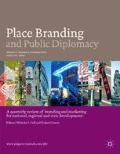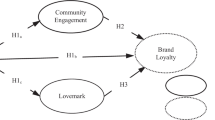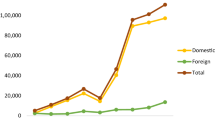Abstract
Place branding is becoming a powerful tool to gain competitive advantage, as it improves the development of a region or country not only in terms of leisure and tourism, but also in terms of attracting investment, new residents, jobs and skilled migrants. Internet websites are essential communication tools for place brands. The aim of this article is to quantify the brand image of Spanish cities according to their visibility on the Internet. After this, the study is focused on the key elements explaining the success of the brand image of Bilbao (Basque Country, Spain), with the Guggenheim Museum being the main icon. This work reveals that cities having a higher visibility on the Internet enjoy a cultural heritage of great wealth. Therefore, cultural tourism may be a key factor that enhances the brand image of these cities with the consequent implications for the growth and development of their regions.






Similar content being viewed by others
Notes
This interactivity that 2.0 technologies enhance allows increasing both the usefulness of the web page and its credibility. It is the case of the sections of comments and ratings from users telling about their experiences in the cities they have visited, as well as the use and enjoyment of hotels.
There may be a small methodological bias in search engines when entering the name of provincial capitals, as in some cases the name is the same as the name of the province. In addition, some provincial capitals can be named as any other city in the world.
Between 1985 and 1997, spending rose from 59 to 82 per cent on its overall budget (Evans, 2003).
The city of Turia will host the Tennis Tournament (Tennis Open 500), the European Grand Prix Formula 1, Valencia Fashion Week, the 33rd America's Cup and the Global Champions Tour (GCT), which is the most prestigious international equestrian circuit in the world.
For more information about cultural heritage and economic encounters, see Lyon and Wells (2012).
This event is part of Spain's cultural calendar and has been enjoyed by thousands of people. It has had a spectacular tourist relevance for this city, which has taken up the challenge of reaching 3 million visitors a year. This kind of tourism is represented by visitors with greater spending power and less environmental impact. In addition, the profile of the cultural tourist is that of an experienced traveller who demands quality (Richards, 2007).
In Spain, cultural tourism is becoming increasingly important. The potential of Spain in this sector is large because of its rich heritage, and within this context some of the museums are regarded as important tourism resources and economic engines (Plaza, 2010) (as it is the case, among others, of the Guggenheim Museum Bilbao, a city under study in this article).
Moreover, this city hosts fairs and various events such as the Festival of the Patios or Futurotextiles. This is a travelling exhibition that combines science and technology applied to textile art. This helps increase the number of visitors, and the brand image of the city is consequently reinforced.
Forecasts of tourist arrivals in the 2011 season indicated a strong recovery from the previous year. The increase in reserves and places offered in almost all source markets is higher than major competitors and consolidated the leadership of Ibiza. The city is also developing a series of events with different European countries (Belgium, Holland, Germany, London) to promote tourism in the island.
References
Allen, G. (2007) Place branding: New tools for economic development. Design Management Review 18 (2): 60–68.
Andersson, M. (2007) Region branding: The case of the Baltic Sea region. Place Branding and Public Diplomacy 3 (2): 120–130.
Anholt, S. (2007) Competitive Identity: The Brand Management for Nations, Cities and Regions. New York: Palgrave Macmillan.
Asworth, G. (2009) The instruments of place branding: How is it done? European Spatial Research and Policy 16 (1): 9–22.
Asworth, G. and Kavaratzis, M. (2010) Towards Effective Place Brand Management. Branding European Cities and Regions. UK: Edward Elgar Publishing Limited.
Buhalis, D. (2006) Strategic use of information technologies in the tourism industry. In: A. Papatheodorou (ed.) Managing Tourism Destinations. Cheltenham, UK: Edward Elgar, pp. 409–421.
Buhalis, D. and Costa, C. (2006) Tourism, Management Dynamics. Trends, Management and Tools. Oxford, UK: Elseiver Butterworth Heinemann.
Buhalis, D. and Neuhofer, B. (2012) Everything you need to know about Internet marketing. Annals of Tourism Research 39 (2): 1266–1268.
Chen, C-F. and Chen, F-S. (2010) Experience quality, perceived value, satisfaction and behavioral intentions for heritage tourists. Tourism Management 31 (1): 29–35.
Chhabra, D. (2010) Sustainable Marketing of Cultural and Heritage Tourism. Arizona: Arizona State University.
Choi, A.S., Ritchie, B.W., Papandrea, F. and Bennett, J. (2010) Economic valuation of cultural heritage sites: A choice modeling approach. Tourism Management (31): 213–220.
Corijn, E. and Mommaas, H. (1995) Urban Cultural Policy Developments in Europe. Strasbourg, France: Council of Europe.
Curtis, J. (2001) Branding a state: The evolution of brand Oregon. Journal of Vacation Marketing 7 (1): 75–81.
De Elizagarate, V. (2008) Marketing de ciudades. Estrategia para el desarrollo de ciudades atractivas y competitivas en un mundo global. Madrid, Spain: Ediciones Pirámide.
De Esteban, J. (2005) Cultural tourism in Spain: Understanding the demand from a post-modern perspective-a case study of Madrid. Dissertation submitted for the Master of Arts ‘European Tourism Management’ Bournemouth University.
Diaz-Luque, P. (2009) Official tourism web sites and city marketing. In: M. Gascó-Hernández and T. Torres-Coronas (eds.) Information Communication Technologies and City Marketing. Digital Opportunities Cities Around the World. Hershey, PA: Information Science Reference.
Dijck, J.V. and Nieborg, D. (2009) Wikinomics and its discontents: A critical analysis of Web 2.0 business manifestos. New Media & Society (11): 855–874.
Essex, S. and Chalkley, B. (1998) Olympics Games: Catalyst of urban change. Leisure Studies 17 (3): 187–206.
Evans, G. (2003) Hard-branding the cultural city - From Prado to Prada. International Journal of Urban and Regional Research 27 (2): 417–440.
Fernandez-Cavia, J. and Huertas-Roig, A. (2009) City brands and their communication through web sites: Identification of problems and proposals for improvement. In: M. Gascó-Hernandez and T. Torres-Coronas (eds.) Information and Communication Technologies and City Marketing: Digital Opportunities for Cities Around the World. Hershey, PA: Information Science Reference, pp. 26–49.
Gascó-Hernández, M. and Torres-Coronas, T. (2009) Preface. In: M. Gascó-Hernandez and T. Torres-Coronas (eds.) Information and Communication Technologies and City Marketing: Digital Opportunities for Cities Around the World. Hershey, PA: Information Science Reference, pp. 12–17.
Gilmore, F. (2002) A country – Can it be repositioned? Spain – The success story of country branding. Brand Management 9 (4–5): 281–293.
Gnoth, J. (2002) Leveraging export brands through a tourism destination brand. Brand Management 9 (4–5): 262–280.
Gold, J. and Gold, M. (2008) Olympic cities: Regeneration, city rebranding, and changing urban agendas. Geography Compass 2 (1): 300–318.
Govers, R. and Go, F. (2009) Place Branding Glocal, Virtual and Physical Identities, Constructed, Imagined and Experienced. New York: Palgrave Macmillan.
Graham, M. and Zook, M. (2011) Visualizing global cyberscapes: Mapping user-generated placemarks. Journal of Urban Technology 18 (1): 115–132.
Hankinson, G. (2004) Relational network brands: Towards a conceptual model of place brands. Journal of Vacation Marketing 10 (2): 109–121.
Hanna, S. and Rowley, J. (2007) An analysis of terminology use in place branding. Place Branding and Public Diplomacy 4 (1): 61–75.
Hazime, H. (2011) From city branding to e-brands in developing countries: An approach to Qatar and Abu Dhabi. African Journal of Business Management 5 (12): 4731–4745.
Hospers, G.F. (2004) Place Marketing in Europe. The Branding of the Oresund Region. Intereconomics.
Ivanovic, M. (2008) Cultural Tourism. South Africa: Juta & Company.
Kaminski, J., McLoughlin, J. and Sodagar, B. (2007) Economic methods for valuing European cultural heritage sites (1994–2006). In: J. McLoughlin, J. Kaminski and B. Sodagar (eds.) Perspectives on Impact, Technology and Strategic Management, Vol. 1. Budapest, Hungary: Epoch, pp. 98–121.
Kavaratzis, M. (2004) From city marketing to city branding: Towards a theoretical framework for developing city brands. Place Branding (1): 58–73.
Kavaratzis, M. and Asworth, G.J. (2005) City branding: An effective assertion of identity or a transitory marketing trick? Tijdschrift voor Economische en Sociale Geografic 96 (5): 506–512.
Kim, H., Cheng, C-K. and O'Leary, J.T. (2007) Understanding participation patterns and trends in tourism cultural attractions. Tourism Management 28 (5): 1366–1371.
Kotler, P., Amstrong, G., Saunders, J. and Wong, V. (2002) Principals of Marketing, 3rd European edn. Essex, UK: Prentice-Hall.
Kotler, P., Asplund, C., Rein, I. and Heider, D. (1999) Marketing Places Europe: Attracting Investments, Industries, Residents and Visitors to European Cities, Communities, Regions and Nations. London: Pearson Education.
Kotler, P. and Gertner, D. (2002) Country as brand, product, and beyond: A place marketing and brand management perspective. Brand Management (4–5): 249–257.
Kotler, P., Haider, D.H. and Rein, I. (1993) Marketing Places. New York: The Free Press.
Li, X., Bing, P., Zhang, L. and Smith, W. (2009) The effect of online information search on image development. Insights from a mixed-methods study. Journal of Travel Research 48 (1): 45–57.
Littrell, M.A. (1997) Shopping experiences and marketing of culture to tourists. In: M. Robinson, N. Evans and P. Callaghan (eds.) Tourism and Culture: Image, Identity and Marketing. New castle: Centre for Travel and Tourism, University of Northumbria, pp. 107–120.
Lyon, S. and Wells, E.Ch. (2012) Global Tourism Cultural Heritage and Economic Encounters. UK: Altamira Press.
Mas, E. (2011) La revitalización del Área Metropolitana de Bilbao: La Gestión de Bilbao Ría 2000, Aspectos territoriales. Boletín de Asociación de Geógrafos Españoles (55): 35–57.
Mckercher, B. and Du Cross, H. (2002) Cultural Tourism: The Partnership Between Tourism and Cultural Heritage Management. New York: Harworth Hospitality Press.
Meta-Net. (2012) A network of excellence forging the multilingual Europe technology alliance, http://www.meta-net.eu/whitepapers.
Navrud, S. and Ready, R.C. (eds.) (2002) Valuing Cultural Heritage: Applying Environmental Valuation Techniques to Historic Buildings, Monuments and Artifacts. Cheltenham, UK: Edward Elgar.
Noonan, D. (2003) Contingent valuation and cultural resources: A meta-analytic review of the literature. Journal of Cultural Economics 27 (3–4): 159–176.
Olins, W. (2002) Branding the nation state - The historical context. Brand Management 9 (4–5): 241–248.
Palmer, A. (2005) The internet challenge for destination marketing organizations. In: N. Morgan, A. Prichard and R. Pride (eds.) Destination Branding: Creating the Unique Destination Proposition. Oxford, UK: Elsevier.
Papadopoulos, N. and Heslop, L. (2002) Country equity and country branding: Problems and prospects. Brand Management 9 (4–5): 294–314.
Plaza, B. (2000) Evaluating the influence of a large cultural artifact in the attraction of tourism. The Guggenheim Museum Bilbao Case. Urban Affairs Review 36 (2): 262–274.
Plaza, B. (2010) Valuing museums as economic engines: Willingness to pay or discounting of cash-flows. Journal of Cultural Heritage 11 (2): 155–162.
Plaza, B. and Haarich, S. (2010) Museums for urban regeneration? Exploring conditions for their effectiveness. Journal of Urban Regeneration and Renewal 2 (3): 259–271.
Porter, M. (1985) Competitive Advantage. New York: The Free Press.
Rainisto, S.K. (2003) Success factors of place marketing: A study of place marketing practices in Northern Europe and United States. Doctoral Dissertation, Helsinki University of Technology, Institute of Strategy and International Business. Retrieved from: http://lib.tkk.fi/fi/, accessed 20 May 2012.
Richards, G. (2001) Cultural tourist or a culture of tourism? The European cultural tourism market. In: J. Butcher (ed.) Innovations in Cultural Tourism, Proceedings of the 5th ATLAS International Conference; Rethymnon, Crete 1998, Tilburg: ATLAS.
Richards, G. (2007) Cultural Tourism. Global and Local Perspectives. London: The Haworth Hospitality Press.
Richards, G. and Munsters, W. (2010) Cultural Tourism. Research Methods. London: CAB International.
Sabaté, J. and Tironi, M. (2008) Rankings, creatividad y urbanismo. Revista Eure XXXIV (102): 5–23.
Sigala, M. (2009) Web 2.0, social marketing strategies and distribution channels for city destinations: Enhancing the participatory role of travellers and exploiting their collective. In: M. Gascó-Hernandez and T. Torres-Coronas (eds.) Information and Communication Technologies and City Marketing: Digital Opportunities for Cities Around the World. Hershey, PA: Information Science Reference, pp. 221–245.
Smith, M. (2009) Issues in Cultural Tourism Studies. New York: Routledge.
Smith, M. and Robinson, M. (2006) Cultural Tourism in a Changing World: Politics, Participation and (Re) Presentation. Clevedon, UK: Channel View.
Stobbe, A. (2009) Hook up for next gains. Economics: Digital economy and structural change Deutsche Bank Research, March, 9.
Stobbe, A. (2010) How companies are tapping the benefits of Web 2.0. Economics: Digital economy and structural change. Deutsche Bank Research, September, 8.
Van Ham, P. (2001) The rise of the brand state: The postmodern political image and reputation. Foreign Affairs 80 (5): 2–6.
Venkatachalam, L. (2004) The contingent valuation method: A review. Environmental Impact Assessment Review 24 (1): 89–124.
World Tourism Organization. (2008) European Travel Commission. Madrid, Spain: Handbook on e-marketing for tourism destinations.
Yeoman, I., Durie, A., McMahon-Beattie, U. and Palmer, A. (2005) Capturing the essence of a brand from its history: The case of Scottish tourism marketing. Journal of Brand Management 13 (3): 134–147.
Zhang, B. and Cheng, W. (2008) The cultural tourism and the protection of intangible heritage. Human Geography (1).
Zukin, S. (2009) Destination Culture: How Globalization Makes All Cities Look the Same, Conference on Rethinking Cities and Communities: Urban Transition before and During the Era of Globalization. Hartford, CT: Centre of Urban and Global Studies, Trinity College.
Acknowledgements
The authors wish to thank the encouragement and support of Professor Beatriz Plaza in the process of elaboration of this article, and the collaboration of Alvaro Fierro in the making of the statistical model.
Author information
Authors and Affiliations
Corresponding author
Rights and permissions
About this article
Cite this article
Alonso, I., Bea, E. A tentative model to measure city brands on the Internet. Place Brand Public Dipl 8, 311–328 (2012). https://doi.org/10.1057/pb.2012.22
Received:
Revised:
Published:
Issue Date:
DOI: https://doi.org/10.1057/pb.2012.22




